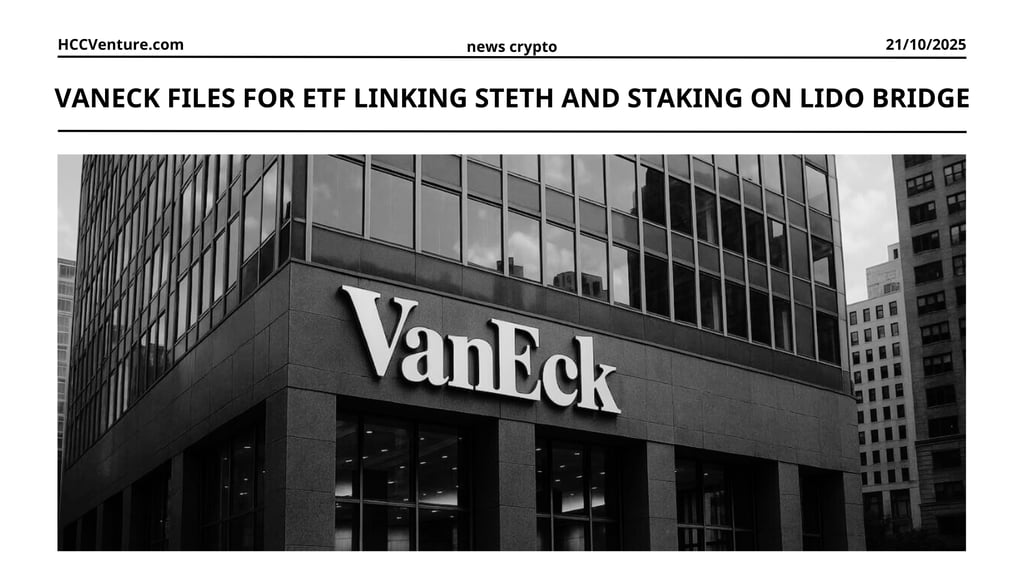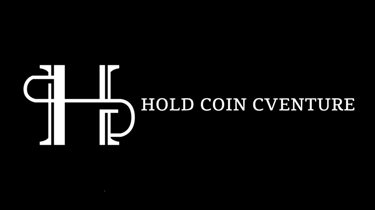VanEck Files for an ETF Linking stETH and Staking on Lido Bridge
VanEck has announced an ETF applicant to launch an ETH portfolio and staking on Lido, the lifeline of DeFi and CeFi, in what would be a watershed moment for the asset class if successful.
10/21/20252 min read


DeFi and CeFi Bridge Launch
In a move that could reshape the intersection between decentralized finance (DeFi) and traditional capital markets, VanEck has filed with the U.S. Securities and Exchange Commission (SEC) to launch the world’s first ETF directly backed by stETH – a tokenized representation of staked Ether issued through Lido Finance.
If approved, this would be the first ETF in history tied to a yield-generating on-chain asset, putting VanEck at the forefront of integrating Ethereum’s staking economy into the regulated investment environment.
Following the successful approval of Bitcoin and Ethereum spot ETFs, attention in the institutional finance world has shifted to staking-based yield products – assets that combine capital growth with on-chain income generation.
With Ethereum staking yields averaging 3.5–4.2% annually, VanEck’s proposed Staked Ethereum ETF would allow investors to access both ETH price performance and staking yields, without directly participating in validation activities or holding private keys.
New Portfolio Mechanics
VanEck — which has been a pioneer in filing Bitcoin and Ethereum ETFs — is now extending its first-mover advantage to DeFi-native yield instruments, potentially setting a precedent for a new class of on-chain income ETFs. According to the filing, the VanEck Staked Ethereum ETF will:
Hold stETH as its primary underlying asset, fully collateralized by ETH staked on Lido.
Reflect the market price of ETH while accruing staking rewards to increase the fund’s net asset value (NAV) over time.
Strengthen compliance by partnering with regulated digital asset custodians and real-time attestation providers.
Maintain transparent performance reporting, reflecting ETH compounding in the fund’s valuation.
Essentially, this product bridges on-chain yield generation and off-chain investor access – turning DeFi staking into a regulated and tradable financial instrument.
Impact on Other DATCOs
This filing marks the first formal attempt to tokenize and securitize staking earnings for mainstream investors. If approved, it would allow funds, pension funds, and sovereign institutions to access Ethereum staking yields through a compliant ETF structure—a step toward large-scale adoption of on-chain yield.
stETH accounts for approximately 30% of all staked ETH, with over $35 billion in total value locked (TVL). VanEck’s choice of stETH as the underlying asset demonstrates deep confidence in Lido’s reliability, liquidity, and dominance in the staking ecosystem—potentially driving new institutional investment into Ethereum staking and liquidity staking.
VanEck’s move could spark a wave of similar filings—from Coinbase’s cbETH, Rocket Pool’s rETH, or even EigenLayer staking derivatives. Asset managers like BlackRock, Franklin Templeton, and Grayscale are likely to explore similar avenues as the lines between on-chain income assets and traditional yield funds become increasingly blurred.
Evaluation and Conclusion
If approved, VanEck’s stETH ETF would be a game-changer for the global market—the first regulated product to capture native on-chain yields within a traditional ETF framework. This would show the world that DeFi is no longer a parallel system, but an integrated layer of global finance, where staking income, liquidity tokens, and decentralized protocols coexist within the institutional ecosystem.
Disclaimer: The information presented in this article is the author's personal opinion in the cryptocurrency field. It is not intended to be financial or investment advice. Any investment decision should be based on careful consideration of your personal portfolio and risk tolerance. The views expressed in this article do not represent the official position of the platform. We recommend that readers conduct their own research and consult with a professional before making any investment decisions.
Explore HCCVenture group
HCCVenture © 2023. All rights reserved.


Connect with us
Popular content
Contact to us
E-mail : holdcoincventure_contact@hccventure.com
Register : https://linktr.ee/holdcoincventure
Disclaimer: The information on this website is for informational purposes only and should not be considered investment advice. We are not responsible for any risks or losses arising from investment decisions based on the content here.


TERMS AND CONDITIONS • CUSTOMER PROTECTION POLICY
ANALYTICAL AND NEWS CONTENT IS COMPILED AND PROVIDED BY EXPERTS IN THE FIELD OF DIGITAL FINANCE AND BLOCKCHAIN BELONGING TO HCCVENTURE ORGANIZATION, INCLUDING OWNERSHIP OF THE CONTENT.
RESPONSIBLE FOR MANAGING ALL CONTENT AND ANALYSIS: HCCVENTURE FOUNDER - TRUONG MINH HUY
Read warnings about scams and phishing emails — REPORT A PROBLEM WITH OUR SITE.
